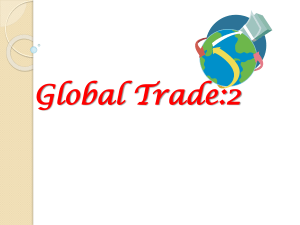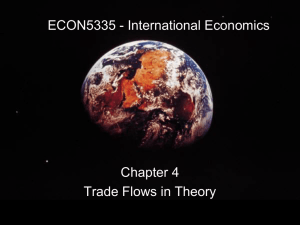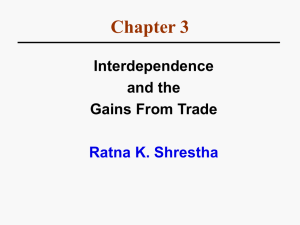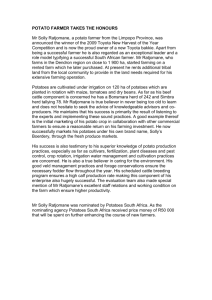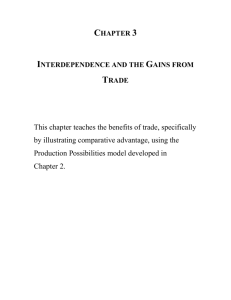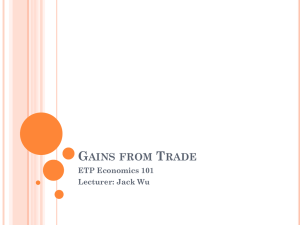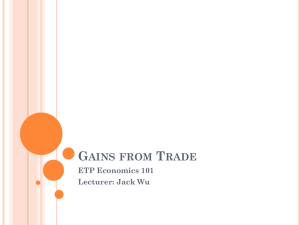Chapter 03 Interdependence and the Gains from Trade
advertisement
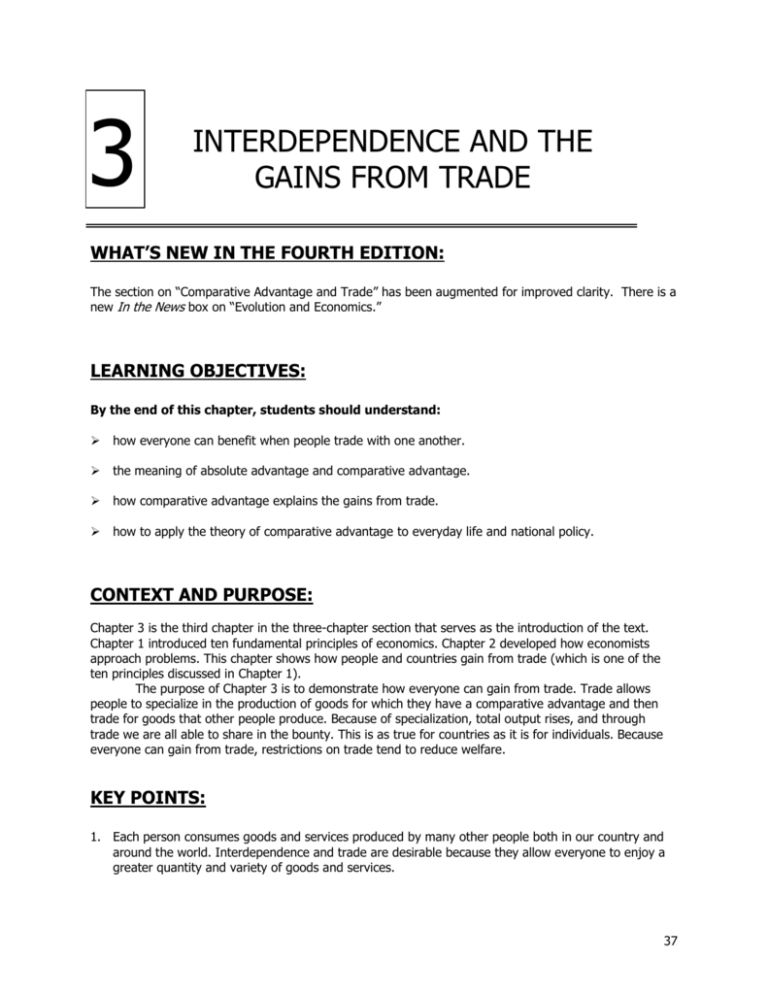
3 INTERDEPENDENCE AND THE GAINS FROM TRADE WHAT’S NEW IN THE FOURTH EDITION: The section on “Comparative Advantage and Trade” has been augmented for improved clarity. There is a new In the News box on “Evolution and Economics.” LEARNING OBJECTIVES: By the end of this chapter, students should understand: how everyone can benefit when people trade with one another. the meaning of absolute advantage and comparative advantage. how comparative advantage explains the gains from trade. how to apply the theory of comparative advantage to everyday life and national policy. CONTEXT AND PURPOSE: Chapter 3 is the third chapter in the three-chapter section that serves as the introduction of the text. Chapter 1 introduced ten fundamental principles of economics. Chapter 2 developed how economists approach problems. This chapter shows how people and countries gain from trade (which is one of the ten principles discussed in Chapter 1). The purpose of Chapter 3 is to demonstrate how everyone can gain from trade. Trade allows people to specialize in the production of goods for which they have a comparative advantage and then trade for goods that other people produce. Because of specialization, total output rises, and through trade we are all able to share in the bounty. This is as true for countries as it is for individuals. Because everyone can gain from trade, restrictions on trade tend to reduce welfare. KEY POINTS: 1. Each person consumes goods and services produced by many other people both in our country and around the world. Interdependence and trade are desirable because they allow everyone to enjoy a greater quantity and variety of goods and services. 37 38 Chapter 3/Interdependence and the Gains from Trade 2. There are two ways to compare the ability of two people in producing a good. The person who can produce the good with a smaller quantity of inputs is said to have an absolute advantage in producing the good. The person who has the smaller opportunity cost of producing the good is said Table 1 to have a comparative advantage. The gains from trade are based on comparative advantage, not absolute advantage. 3. Trade makes everyone better off because it allows people to specialize in those activities in which they have a comparative advantage. 4. The principle of comparative advantage applies to countries as well as people. Economists use the principle of comparative advantage to advocate free trade among countries. CHAPTER OUTLINE: Begin by explaining that there are two basic ways that individuals can satisfy their wants. The first is to be economically self-sufficient. The second is to specialize in the production of one thing and then trade with others. With rare exceptions, individuals and nations tend to rely on specialization and trade. One way to demonstrate this is to survey the students on their future plans (doctors, lawyers, teachers, etc.). Point out that they plan to specialize and trade. Ask them why this is optimal. I. A Parable for the Modern Economy A. B. Example: two goods—meat and potatoes; and two people—a cattle rancher and a potato farmer (each of whom likes to consume both potatoes and meat). 1. The gains from trade are obvious if the farmer can only grow potatoes and the rancher can only raise cattle. 2. The gains from trade are also obvious if, instead, the farmer can raise cattle as well as grow potatoes, but he is not as good at it and the rancher can grow potatoes in addition to raising cattle, but her land is not well suited for it. 3. The gains from trade are not as clear if either the farmer or the rancher is better at producing both potatoes and meat. Production Possibilities 1. The farmer and rancher both work eight hours per day and can use this time to grow potatoes, raise cattle, or both. 2. Table 1 shows the amount of time each takes to produce one ounce of either good: Chapter 3/Interdependence and the Gains from Trade 39 Minutes Needed to Make One Ounce of: 3. 4. Amount Produced in Eight Hours Meat Potatoes Meat Potatoes Farmer 60 min./oz. 15 min./oz. 8/1=8 oz. 8/0.25=22 oz. Rancher 20 min./oz. 10 min./oz. 8/0.33=24 oz. 8/0.16=48 oz. The production possibilities frontiers can also be drawn. a. These production possibilities frontiers are drawn linearly instead of being bowed out. This assumes that the farmer's and the rancher's technology for producing meat and potatoes allows them to switch between producing one good and the other at a constant rate. b. As we saw in Chapter 2, these production possibilities frontiers represent the principles of trade-offs and opportunity costs. We will assume that the farmer and rancher divide their time equally between raising cattle and growing potatoes. Figure 1 a. The farmer produces (and consumes) at point A—16 ounces of potatoes and 4 ounces of meat. b. The rancher produces (and consumes) at point B—24 ounces of potatoes and 12 ounces of meat. 40 Chapter 3/Interdependence and the Gains from Trade C. Specialization and Trade 1. Suppose the rancher suggests that the farmer specialize in the production of potatoes and then trade with the rancher for meat. a. The rancher will spend six hours a day producing meat (18 ounces) and two hours a week growing potatoes (12 ounces). b. The farmer will spend eight hours a day growing potatoes (32 ounces). c. The rancher will trade 5 ounces of meat for 15 ounces of potatoes. Figure 2 Table 2 2. 3. II. End results: a. The rancher produces 18 ounces of meat and trades 5 ounces, leaving him with 13 ounces of meat. He also grows 12 ounces of potatoes and receives 15 ounces in the trade, leaving him with 27 ounces of potatoes. b. The farmer produces 32 ounces of potatoes and trades 15 ounces, leaving him with 17 ounces. He also receives 5 ounces of meat in the trade with the rancher. In both cases, they are able to consume quantities of potatoes and meat after the trade that they could not reach before the trade. Comparative Advantage: The Driving Force of Specialization A. Absolute Advantage Chapter 3/Interdependence and the Gains from Trade 41 B. 1. Definition of absolute advantage: the ability to produce a good using fewer inputs than another producer does. 2. The rancher has an absolute advantage in the production of both potatoes and meat. Opportunity Cost and Comparative Advantage 1. Definition of opportunity cost: whatever must be given up to obtain some item. Table 3 2. 3. C. a. For the rancher, it takes ten minutes to produce one ounce of potatoes. Those same ten minutes could be used to produce one-half ounce of meat. Thus, the opportunity cost of producing an ounce of potatoes is one-half ounce of meat. b. For the farmer, it takes 15 minutes to produce one ounce of potatoes. Those same 15 minutes could be used to produce one-fourth ounce of meat. Therefore, the opportunity cost of producing one ounce of potatoes is one-fourth ounce of meat. c. The opportunity cost of producing one ounce of meat is the inverse of the opportunity cost of producing one ounce of potatoes. Definition of comparative advantage: the ability to produce a good at a lower opportunity cost than another producer. a. The farmer has a lower opportunity cost of producing potatoes and therefore has a comparative advantage in the production of potatoes. b. The rancher has a lower opportunity cost of producing meat and therefore has a comparative advantage in the production of meat. Because the opportunity cost of producing one good is the inverse of the opportunity cost of producing the other, it is impossible for a person to have a comparative advantage in the production of both goods. Comparative Advantage and Trade 1. When specialization in a good occurs (assuming there is a comparative advantage), total output will grow. 2. As long as the opportunity cost of producing the goods differs across the two individuals, both can gain from specialization and trade. a. The farmer buys 5 ounces of meat with 15 ounces of potatoes. This implies that the price of each ounce of meat is three ounces of potatoes, which is lower than the farmer's opportunity cost of four ounces of potatoes. Trade is beneficial to the farmer. 42 Chapter 3/Interdependence and the Gains from Trade b. III. IV. The rancher buys 15 ounces of potatoes for 5 ounces of meat. The price of each ounce of potatoes is one-third ounce of meat. This is lower than the rancher's opportunity cost of one-half ounce of meat. Trade also benefits the rancher. FYI: The Legacy of Adam Smith and David Ricardo A. In Adam Smith's 1776 book An Inquiry into the Nature and Causes of the Wealth of Nations, he writes of the ability of producers to benefit through specialization and trade. B. In David Ricardo's 1817 book Principles of Political Economy and Taxation, Ricardo develops the theory of comparative advantage and argues against restrictions on free trade. C. The benefits of free trade are an issue that is generally agreed upon by most economists, and the theories and arguments developed by these two individuals 200 years ago are still used today. Applications of Comparative Advantage A. B. Should Tiger Woods Mow His Own Lawn? 1. Imagine that Woods can mow his lawn faster than anyone else can. 2. This implies that he has an absolute advantage. 3. Suppose that it takes him two hours to mow his lawn. In that same two hours, he could film a commercial for Nike for which he would earn $10,000. This means that the opportunity cost of mowing his lawn is $10,000. 4. It is likely that someone else would have a lower opportunity cost of mowing Woods’ lawn; this individual would have a comparative advantage. 5. Both he and the person hired will be better off as long as he pays the individual more than the individual's opportunity cost and less than $10,000. Should the United States Trade with Other Countries? 1. Just as individuals can benefit from specialization and trade, so can the populations of different countries. 2. Definition of imports: goods produced abroad and sold domestically. 3. Definition of exports: goods produced domestically and sold abroad. 4. The principle of comparative advantage suggests that each good should be produced by the country with a comparative advantage in producing that good (smaller opportunity cost). 5. Through specialization and trade, countries can have more of all goods to consume. Chapter 3/Interdependence and the Gains from Trade 43 6. C. Trade issues among nations are more complex. Some individuals can be made worse off even when the country as a whole is made better off. In the News: Evolution and Economics 1. The theory of comparative advantage may help to explain evolution. 2. This is an article from The Economist that describes research by an economist at the University of Wyoming who suggests that trade and specialization are the primary reasons why Homo sapiens remain the only species of humanity.

